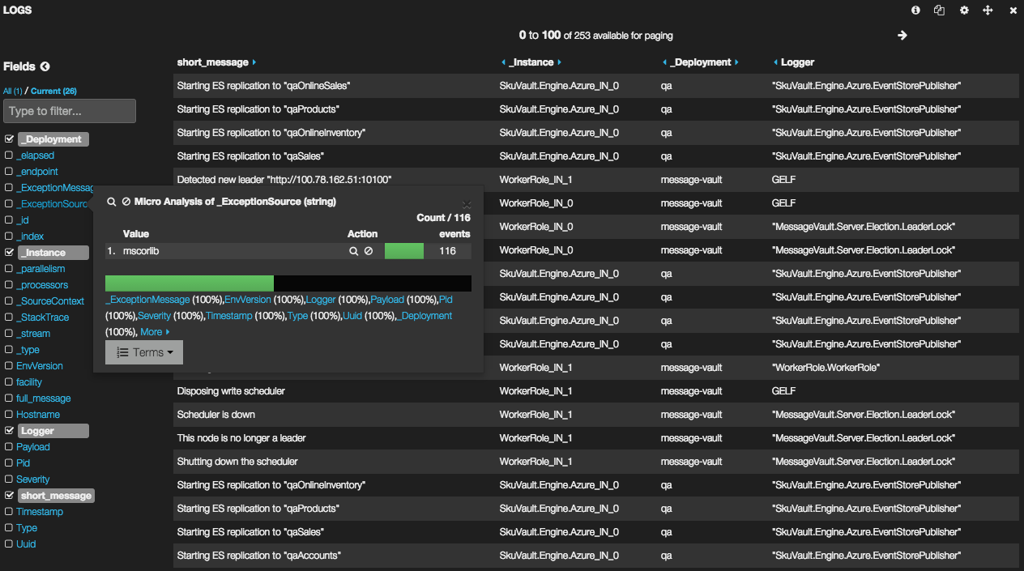Delivering First Bits to QA
Deploying MessageVault
This week we finally pushed our MessageVault project to QA deployment. It will live there for some time, before going to production.
To remind you, MessageVault is a simple message storage server that runs on Windows Azure. It is inspired by Apache Kafka. This server allows saving messages as streams to page blobs on Windows Azure Storage. Streams can reach terabytes and go beyond. Once we persisted messages to Azure Storage, we could read them directly from there, MessageVault server is not needed for that. You can have any number of consumers reading them or even replaying from the start.
All events that are recorded in QA deployment of SkuVault, get pushed to dedicated streams on MessageVault. It is easy to consume them from any code at this point. From now we could start migrating some existing logic to dedicated modules to do reporting, exports, serve as API etc.
The most important benefit of MessageVault setup is that it would allow to:
-
Implement some of the existing functionality as stand-alone modules with API.
-
Scale out the solution by batch processing messages, and adjusting implementation of each module according to the use-case.
-
Experiment with writing new modules without risking the integrity of the existing solution.
-
Simplify existing solution, by replacing integration via commands and views with integration via crafted domain events.
-
Introduce testability of API modules as one whole.
-
Simplify front-end (no need to query multiple key-value documents in order to display one simple report or a view).
What's more important - these changes could happen incrementally without big rewrites to the system. At least that's the plan. We'll see how the things would work out in the next weeks.
You might get an impression that we are going to transform a large application into a crowd of small micro-services in .NET. This is not entirely true. In fact, the number of projects could even go down, as we reduce coupling and duplication of view logic.
We had to learn limitations, week points and scaling possibilities of MessageVault. So it went through some intensive stress-testing before the QA. The best approach was to deploy the system and test it in different scenarios.
For example, these are the throughput numbers (transactions per second and messages per second) and latencies while running it on Large, Medium and Small instances of Windows Azure Role.

As you can see, MessageVault doesn't handle long-term load well, if deployed as Small Azure Service. It handles load better (and with lower latencies), if deployed as Large Azure Service.
These performance numbers are preliminary, there are things that could see improvement (e.g. improving scheduler for high-throughput scenarios). However, we are going to do an internal code-review of the project before moving forward with it.
This approach follows the mantra: first make it work, then make it beautiful; afterwards make it fast.
You could check out the sources and performance for yourself. MessageVault is available on github as part of AgileHarbor repository. It includes libraries for the client and server along with examples and an Azure deployment you can use.
Hekad Gateway
Graphite statistics on the image above are a courtesy of our dedicated devops server. The same server also provides a nice UI to access and search logs in real-time.

In order to benefit from these capabilities, a code has to know how to push data to this devops server. Integration between .NET and Linux proved to be the most tricky part. However today, we pushed to QA a first deployment of SkuVault with real-time statistics and logging enabled.
SkuVault codebase itself isn't instrumented with performance counters yet. However, it became easy to do so. This will allow to learn behavior of the system in real-time, understand the bottlenecks and improve performance for the users.
The integration project for pushing logs and statistics from .NET code to Hekad is available as open source. It is probably too specific for reuse, but it could serve as sample.
Breaking the Build
Fun fact: in the process of QA deployment I broke the build half a dozen times. The project didn't compile on my machine due to a private dependency I didn't have. So I had to be pretend to be a compiler and MSBuild, verifying my own changes in the head before pushing them to the build server.
It all worked in the end, but I probably didn't leave a good impression of a first-time committer to the core codebase :)
SkuVault Record
Obviously, the development effort in SkuVault didn't focus just on DevOps and messaging middleware. The team was busy improving user experience and stability of the rapidly growing product.
By the way, during last Black Friday, SkuVault storage broke the record of 100M events stored in the system. At this point in time, there were more than 4.5M sales created in SkuVault in total (throughout the history) and 2.3M sale items picked. Kudos to the team of SkuVault for reaching these impressive numbers and exceeding them.
Next Steps
In the next weeks we'll be working on migrating some of the existing logic to a simpler event-driven design, as well as planning and prototyping new features for the product.
Published: January 17, 2015.
Next post in SkuVault story: Simplifying Web UI
🤗 Check out my newsletter! It is about building products with ChatGPT and LLMs: latest news, technical insights and my journey. Check out it out